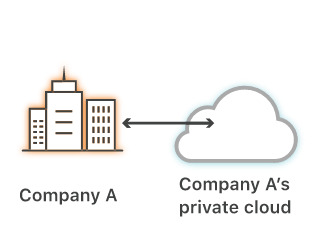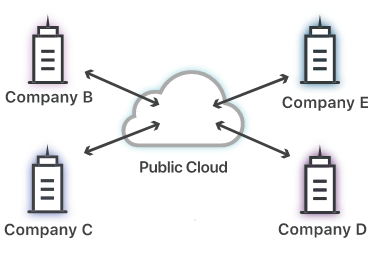A public cloud is a cloud service provided by a cloud provider to multiple customers. The term “public cloud” is used to distinguish between the original cloud model and the private cloud model of services accessed through the Internet. Public clouds include SaaS, PaaS and IaaS services.
Like all cloud services, public cloud services run on remote servers managed by the provider. Customers of this provider can access these services over the Internet.
What is the difference between a public cloud and a private cloud?
Private Cloud

A private cloud is a cloud service that is not shared with any other organization. Private cloud users own their own clouds.
Public Cloud

In contrast, a public cloud is a cloud service that shares computing services between different customers, even if the data and applications that each customer runs in the cloud are still hidden from other cloud customers.
A public cloud is like renting an apartment, while a private cloud is like renting a house of the same size. This house is more private, but usually costs higher rents, and this is not the most efficient way of using resources. The maintenance of the apartment is the responsibility of the construction supervisor, but it is difficult to find a contractor to repair the house sometimes, the tenant may have to do it himself.
There are managed private clouds provided by third-party cloud providers and internal private clouds (managed and maintained internally by the organization).
Pros and Cons of Using a Public Cloud
Pros | Cons |
– Cost savings: Migrating to the public cloud is a way for companies to reduce IT operating costs. Essentially, they outsource these costs to a third party that can handle these costs more efficiently. The cost of a public cloud is usually lower than that of a private cloud because cloud providers can maximize the use of hardware and increase profits by selling services to multiple customers at once. – Reduce server management: If the organization uses a public cloud, internal teams do not have to spend time managing servers—just like dealing with old on-premises data centres or internal private clouds. – Security: Many small and medium enterprises may not have the resources to implement strong security measures. By using public cloud services, they can outsource certain aspects of network security to large providers with more resources. | – Security and compliance issues: For companies that need to meet strict compliance standards, multi-tenancy can be an issue. Multi-tenancy also has a small risk of data leakage, which may be greater than the risk that some companies in the professional field are willing to bear. (In fact, the risk is small; most cloud providers follow extremely high-security standards.) Finally, it may be difficult to deploy the same security policies for the organization’s internal resources and public clouds that are beyond the organization’s control. (Especially during cloud migration). – Vendor lock-in: This is always a concern of cloud technology. Organizations that use the cloud will save money and become more flexible, but ultimately may also rely on the services of cloud providers-virtual machines, storage, applications, and technology they provide to maintain business operations. |


